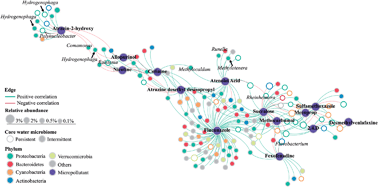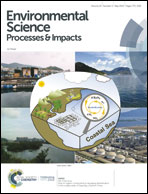Exploring co-occurrence patterns between organic micropollutants and bacterial community structure in a mixed-use watershed†
Abstract
Complex mixtures of low concentrations of organic micropollutants are commonly found in rivers and streams, but their relationship to the structure of native bacterial communities that underlie critical ecological goods and services in these systems is poorly understood. To address this knowledge gap, we used correlation-based network analysis to explore co-occurrence patterns between measured micropollutant concentrations and the associated surface water and sediment bacterial communities in a restored riparian zone of the Des Plaines River (DPR) in Illinois that is impacted by both wastewater treatment plant (WWTP) effluent and agricultural runoff. Over a two year period, we collected 55 grab samples at 11 sites along the DPR and one of its tributaries (48 surface water samples) and from WWTP effluent (7 samples), and screened for 126 organic micropollutants. In parallel, we used high-throughput 16S rRNA gene amplicon sequencing to characterize the bacterial community in sediment and surface water. Our results revealed quantifiable levels of 102 micropollutants in at least one surface water or WWTP effluent sample, 85 of which were detected in at least one surface water sample. While micropollutants were temporally and spatially variable in terms of both presence and concentration, 21 micropollutants were measured in over 75% of the 48 surface water samples. 16S rRNA gene sequencing documented diverse bacterial communities along the DPR transect, with highly distinct community structures observed in sediment and water. Bacterial community structure in surface water, but not in sediment, was significantly associated with concentrations of micropollutants, based on a Mantel test. Correlation-based network analyses revealed diverse strong and significant co-occurrence and co-exclusion patterns between specific bacterial OTUs and both micropollutant groups (defined based on k-means clustering on chemical substructure) and individual micropollutants. Significantly more associations were documented between micropollutants and bacterial taxa in the water compared to the sediment microbiomes. Taken together, our results document a significant link between complex mixtures of micropollutants commonly found in aquatic systems and associated bacterial community structure. Furthermore, our results suggest that micropollutants may exert a more significant impact on water-associated than on sediment-associated bacterial taxa.



 Please wait while we load your content...
Please wait while we load your content...